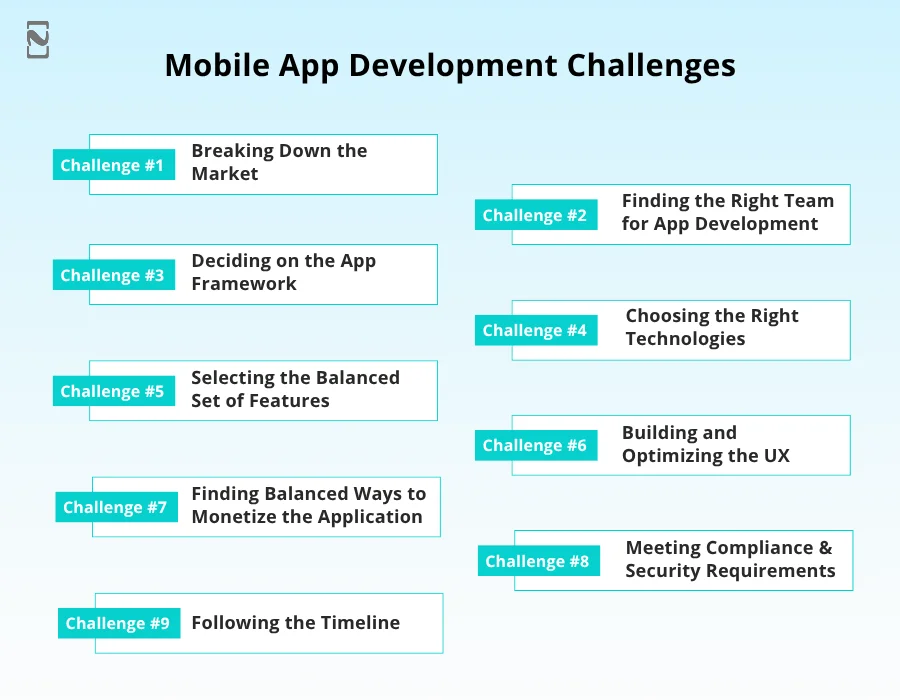Building a mobile app in 2025 has become a mandatory requirement for businesses. While the app in itself is a solution to several challenges for a company, creating one is a different ball game altogether.
Having an idea and implementing it, bringing it to life, converting what you dreamed of into a fully functioning reality, is truly an amazing feat to achieve.
However, the path is not as simple. From understanding the market to finding the right partner for your needs, every step in the app development process comes with a challenge of its own.
In this post, let us take a look at the top mobile app development challenges that you might come across while building your platform. More importantly, we will focus on facing these challenges while developing a mobile app and overcoming them.
If you plan to enter the digital realm with an app of your own, this is definitely a must-read for you. So without further ado, let’s begin!
8+ Mobile App Development Challenges & Their Solutions
When building a mobile app, there are a series of steps that you have to take. And understandably, when following these steps, you may come across several roadblocks. These roadblocks can hamper your course of action, which can further cause loss of time, resources, and, of course, money.
If you have an idea for starting a mobile app business that you want to execute and are planning a mobile app for your business, make sure that you are aware of the following challenges that you might face.

Challenge #1 – Breaking Down the Market (Research & Analysis)
The first challenge for any business or individual planning to build an app is dissecting the current market.
You see, every app you plan to build looks promising, unique, & profitable when you envision it. It’s only after market research that you can truly identify the potential of your idea.
However, researching the market is not as simple as searching on Google. You need to understand the niche properly and then look for insights on how the field works.
And not all are equipped with the tools and mindset necessary to carry out thorough research. Sure, you can find market stats, but to interpret them and find insights, you may need the assistance of a professional analyst.
Solution:
Research and market analysis require you to be open. Do not start your research with a preconceived idea that what you plan to do is pathbreaking.
Let your findings define the stature of the idea that you have in your mind and whether you should make it your business or not.
Another thing you should do is have a professional guide you in the market analysis. This way, you will be able to see right through the data and make decisions with more insight.
Challenge #2 – Finding the Right Team for App Development
Understanding the market gives you an edge over the existing competitors in the field, as you have the advantage of addressing the gaps that they have left.
However, knowing the issues is not the solution. You need a team that understands those issues as closely as you and works to resolve them. That brings us to another challenge, the challenge of finding the right team.
You see, with the rise in digital transformation, thousands of app development professionals have emerged in the market.
Each of them has a different approach, a different way of working. Choosing whether you want to hire a freelancer, an in-house team, or outsource the work is a confusing thing to decide.
Solution:
You need to identify your goal in the long term. Sure, you need professional development experts who not only help you develop the app but also identify the issues that you might have missed addressing in the research phase. The right set of people in your team can help guide you through the entire process.
Compare the options that are available to you and analyse what kind of team you can afford and sustain. This is the ultimate way to have a pool of resources that gets the job done.
Challenge #3 – Deciding on the App Framework
Now that you have already decided on the niche, understood the market, and have a team of experts, you now need to decide on the mobile app framework.
You can either go for native app development, which requires you to build two code bases to run your application on both the platforms, i.e., Android & iOS. Or you can opt for a hybrid app framework that only needs a single codebase.
Now, while it may seem like hybrid app frameworks are a much better choice as they allow you to target a wider audience with less work.
You have to keep in mind that native apps are built as per the OS, allowing them to make the most of a device’s capabilities.
Now, native vs hybrid apps is where things get confusing, as you surely want a higher reach, but compromising on the app performance is certainly a huge trade-off. And building native apps for both platforms can hurt the budget.
Solution:
If you are worried about making the right choice of app framework, the first thing you need to do is identify the trends in the niche that you have chosen.
Of course, knowing how much you want to invest is a crucial deciding factor. So, if you have a limited budget to begin with, learn about your potential user, and find out which platform has a more open audience that you can capitalize on.
Another important thing to consider is the time-to-market that you hold. If you want to hit the market as soon as possible, building an app with a single codebase can be beneficial.
Challenge #4 – Choosing the Right Technologies
Another challenge is selecting the tech stack for your app from the array of technologies available on the market.
With new technologies emerging periodically, it can be challenging to find the right combination that not only enables integrations but also allows the app to remain future-proof.
You see, with new technologies and frameworks taking over the development process, it can get hard to make the right choice.
Some apps are still using legacy technologies as they offer much more support and availability of resources; however, they sure look outdated and require a complete revamp.
On the other hand, apps that are using the latest technologies can help in implementing newer features, but lack support and experts as they are relatively new.
Solution:
Finding the technology that can get the job done should be your first priority. Don’t look for gimmicks or what is recently released.
Instead, look for tools that help you implement the feature with the best efficiency. Also, if you are planning to build an app on a budget, you should choose a technology that already has a lot of resources available in the market. That way, you will be able to hire a resource easily, with less competition.
Finding the right technology is usually the job of the expert whom you hire. Hence, make sure you choose the right app development partner who has expertise in choosing the right tech stack.
Challenge #5 – Selecting a Balanced Set of Features
When choosing the features of your app, businesses usually go overboard and try to get a lot done through the app.
In the course of selecting these features, people often make the mistake of skipping the most basic features. That is why choosing a balanced set of functionalities that help in getting the job done is a challenge.
Another issue that makes feature selection a hassle for the users is the ability of team to implement those functionalities.
If the features are not properly implemented, the app will malfunction, which can be a nightmare for any business/brand. As they say, never sign checks that you can’t cash!
Solution:
The best way to choose the set of features in your app is to study the current market and identify what features it lacks.
Also, if you feel there’s nothing new you can offer, you should check for the gaps and irregularities in the currently available solutions, and you can accordingly resolve them. You can always refine the existing features to meet the user’s requirements.
Study the market and avoid choosing gimmicky features that just complicate the experience, to give your app a standout feature that is hardly used by the user. Keep the use case in mind and then scout the features to include.
Challenge #6 – Building and Optimizing the UX
This is the challenge that has actually led apps to fail in the past few years. While people look for apps that can help them achieve an objective or get something done, the primary requisite is always a handy user experience.
If the user experience is not defined properly, you will never be able to convert a temporary user into a permanent user.
Another challenge is keeping the consistency of the user experience throughout the devices that it supports. A uniform design is certainly appreciated by all.
The challenge is real, especially for those apps that have been created for multiple devices, ranging from tablet PCs, smartphones (both iOS, Android), and wearable devices etc.
Solution:
The best way to handle the UX design and optimization is to choose the right technologies that help in responsive and progressive designs.
The optimization certainly needs time and regular testing. The more you can test on all devices, the better it can be optimized to work according to different screen resolutions and device resources.
The design and UX can be defined from the very beginning stage of the development, which is wireframing. Pay attention to the smallest of details and allow the designer to give input on the design, as they have better experience in finishing the apps.
Challenge #7 – Finding Balanced Ways to Monetize the Application
Another issue that mobile app builders face is finding the right way to monetize the application. You see, offering a subscription and showing ads is the most common way to monetize an app. However, integrating those features into the app and that so at the correct places is crucial.
One cannot keep showing ads while a user is in the middle of using the app, as it causes hindrance in the experience, driving the user away from it.
Not to mention, not all apps can use these monetization techniques. Hence, finding an appropriate solution to monetize the app that allows you to generate revenue without compromising the user experience is a challenge.
Solution:
Ideally, knowing ways to monetize a mobile app can be of great assistance. Try using the app from scratch and identify the gaps where you can place ads or introduce a feature that allows you to monetize. Adding premium features is a good way to start, as these features can definitely earn you some bucks.
You can also turn the processing or waiting screens in your app into ad space. In that way, a user is already waiting for a search or process to finish, might as well interact with the ad, solving your issue of monetizing the app.
Challenge #8 – Meeting Compliance & Security Requirements
One of the most common app development challenges that almost every business building an app for the first time faces is meeting the compliance security requirements for the app.
These requirements keep changing from region to region, which makes the implementation more and more typical for the developers.
Failure to meet these requirements can lead to suspension of the app from the market. For instance, if you have a lending app, meeting digital lending app compliance requirements is a must, along with other fintech app regulations that may or may not apply to your app.
Solution:
Breaking down every requirement is the key. The better you can understand the compliance requirements beforehand, the easier it is to implement them.
Usually, this challenge appears when you have designed the app already, without keeping appropriate data security measures.
Hence, the best solution is to note the compliance requirements before executing the development process, and then you can easily build your app around those requirements.
Challenge #9 – Following the Timeline
The app development process is certainly not a day’s work. It needs to be planned out according to the complexity of the application. When you are planning to launch an app, hitting the market at the right time is the key. The better your timing is, the more impactful your app launch will be.
And that is where the challenge of following the timeline begins. Every step of the development process requires a set time, and while there are experts who can get things in line, there are times when the timeline is missed, causing unnecessary delays.
Solution:
Plan the application accordingly and define your expectations of the deliverables clearly to the development company.
In case you are wondering what can be done to ensure a timely app development, make sure you hire resources as per the requirement and do not delay decision-making from your end.
While all these challenges are quite daunting, the solutions do give you a sigh of relief. All in all, what matters is the decisions you make and the clarity you have while making decisions.
The clearer you are about what you want the final app to look like, the easier it will be to navigate towards it.
Let Nimble AppGenie Take Care of These Challenges for You!
When we talk about clarity in the app development process, the key responsibility falls on the development team that you hire.
The more explicitly they can share about the choices you make, the more confidently you can decide.
For instance, being a technical expert, it is the role of your developers and analysts to guide you in choosing the right technologies, the right set of features, and a perfectly balanced experience that is future-proof.
Hence, the role of your development partner is highly significant.
At Nimble AppGenie, we understand the importance that an app holds for a business, and hence, we only recommend things that can be of help in the long run. Reach out to our experts and discuss your idea today for a better tomorrow!
Conclusion
The path towards a fully functional app is not an easy one to cross. There are several issues that you might face.
What’s more beneficial for a new app is to identify these challenges and resolve them as they appear. Clarity and the right mobile app development company can help you in the long run.
Hope this blog helps you understand the core challenges and how you can overcome them while building the app for your business.
Identifying the issues in the early stages and staying clear about your goal is the ultimate way you build a rock-solid app.
That will be all for this post. Thanks for reading, good luck!
FAQs

Niketan Sharma, CTO, Nimble AppGenie, is a tech enthusiast with more than a decade of experience in delivering high-value solutions that allow a brand to penetrate the market easily. With a strong hold on mobile app development, he is actively working to help businesses identify the potential of digital transformation by sharing insightful statistics, guides & blogs.
Table of Contents






No Comments
Comments are closed.